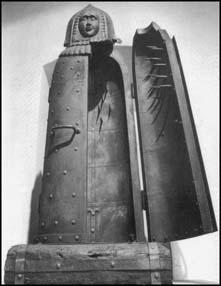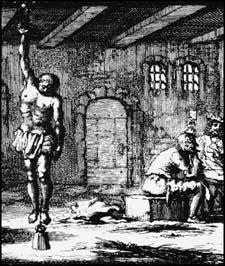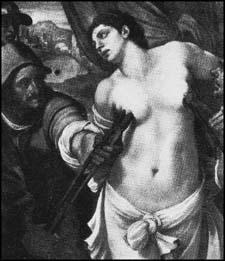The Big Book of Pain: Torture & Punishment Through History (37 page)
Read The Big Book of Pain: Torture & Punishment Through History Online
Authors: Daniel Diehl

IMPALING
Impalement takes no special skill. The only equipment necessary is a victim and a pole stout enough to support his body. In practice, the usual means of impaling was to place the victim on the ground, or a convenient table, and ram the pole as far up his rectum as possible without ripping his head off. The pole and its writhing decoration was then set into a hole in the ground where it could be seen by all and sundry. If the executioner managed to miss the heart, the victim could remain alive, shrieking in agony, for several hours. History’s most famous practitioner of this macabre art form was undoubtedly Prince Vlad II of Walachia (reigned intermittently 1448–76), known properly as Vlad Dracula (that is Vlad, son of the dragon, in honour of his father, Vlad Sr, upon whom the Order of the Dragon had been bestowed) or, more frequently, Vlad Tepes, meaning Vlad the Imapler. Although there have been others who impaled their enemies, Vlad took it to extremes, decorating the no-go zone around his castle with the carcasses of thousands of Turkish enemies. Needless to say, the Turks subsequently left Vlad and his territories off their list of places to visit.

Iron Maiden.
IRON MAIDEN
That uniquely Germanic invention, the Iron Maiden, originated in the town of Nuremberg at some point in the high-middle ages; probably in the 1400s. The item in question – known in German as the
Eiserne Madchen
– looked very much like an Egyptian mummy case, its outer surface carved with the likeness of a woman. The inner surface of both the door and case were set with 4–6in-long spikes. When a victim was pushed into the case and the door was closed they would inevitably and unavoidably be pierced from all directions at once. The purpose however, was not always to kill instantly. The spikes were carefully measured so that they would not pierce to the heart. Presumably, now and again someone would open the case and see if the victim had reconsidered his situation; consent presumably leading to extraction and at least the possibility of survival. The Iron Maiden was never a mass-produced, commercially available item and consequently each model differed slightly. Some were meant to kill instantly and some had long spikes conveniently located so as to pierce the eyes and enter the brain. Although the Maiden is most associated with medieval Germany, it is hardly surprising that it was adopted by the Spanish and Italians. Equally unsurprising is that someone thought of a similar device long before the Middle Ages. The earliest known version of such a device comes down to us from ancient Sparta where the local dictator, Nabis, commissioned an iron statue of his wife, Apega. The statue was so designed that its spring-loaded arms could be opened to expose a nasty set of spikes. When Nabis felt an interview was getting nowhere, he would have his victim shoved into his wife’s arms, which would then snap shut, crushing the man against the spikes. Presumably, as the spikes would have been located at about chest height, extraction and survival were not options.

Iron Maiden.

Impalling of infants.
LING CHE
Translating roughly as Death by One Thousand Cuts, the Chinese
Ling Che
may well be the most lingering and painful death imaginable. According to tradition, the victim was tied to a table while the executioner appeared with a cloth-covered basket filled with knives, each knife bearing a symbol denoting a particular portion of the body. Reaching under the cloth he would extract a knife at random and slice off the specified body part. Fingers, calf muscles, breasts, thigh muscles, nose, eye lids, it was all in the luck of the draw. Given the right random set of circumstances the torture could go on for hours on end. Inevitably, one knife was marked with the symbol for the heart. When this item appeared the victim’s suffering would end in a matter of seconds. Presumably, there were instances where the condemned man’s family bribed the executioner to find the heart knife immediately. An almost identical torture was practiced in Japan where it was called Death by Twenty-One Cuts, presumably based on the possible number of knives involved.

Decapitated heads following Chinese execution of pirates.

Pass (or cradle).
PASS (OR CRADLE)
This little grotesquery seems to have been unique to the Germans and may have been intended for towns that could not afford an Iron Maiden of their own. Looking disturbingly like an over-sized baby’s cradle the
Pass
was a large, rectangular wooden box with rockers affixed to the bottom. The interior surfaces of the ‘cradle’ were set with sharpened iron spikes; when the victim had been stripped naked and lowered into the
Pass
, it was rocked violently back and forth. The results seem too self-evident to require description.

Pendulum.
PENDULUM
Any reader who would be drawn to pick up this book and read thus far will undoubtedly be familiar with Edgar Allan Poe’s story entitled ‘The Pit and the Pendulum’. It tells a macabre story in which a man is cut in half by a giant clockwork pendulum with a weighted blade whose edge was as sharp as a razor. As the clockwork winds down the pendulum slowly descends, a fraction of an inch at a time, allowing the victim to see his own horrific death coming toward him over the course of several hours. The story may be fictional but the device was all too real and was yet another bizarre invention thanks to the creativity of the Spanish Inquisition.
We have found that sometimes the torture of the pulley also known as suspension or
garrucha
or
Squassation
was occasionally referred to as the pendulum. This seems to have been especially so when the torture victim had heavy weights attached to their ankles or toes and were made to swing back and forth while suspended in the air. For more on this variation see
garrucha
on p.204.

Pincers.
PINCERS
Ripping strips of flesh from victims’ bodies with pincers, which looked and worked much like an over-sized pair of pliers, was a common form of pre-execution mutilation employed across much of Continental Europe throughout the Middle Ages.
Although the English seem not to have used the pincers, the French, Germans, Dutch and others found them quite attractive. In some instances the pincers were heated red-hot as a means of increasing the pain. In France, if the victim was not to be put to death, the gaping wounds left by the pincers were further tormented by having boiling wax or hot lead dumped into them.

